#transmission service in Georgetown
Explore tagged Tumblr posts
Text
Best Transmission for Yukon-GMC in Georgetown: Top Repair Services by BS Auto Supplies
When it comes to keeping your Yukon-GMC running smoothly, choosing the right transmission is essential. At BS Auto Supplies, we specialize in providing the best transmission for Yukon-GMC in Georgetown, ensuring your vehicle operates at peak performance. Whether you’re in need of a transmission replacement, repair, or maintenance, our expert team offers comprehensive services tailored to your needs.
We pride ourselves on delivering the best transmission repair in Georgetown. Our experienced technicians use the latest diagnostic tools and high-quality parts to fix any transmission issue, no matter the complexity. From slipping gears to unusual noises, we ensure that your Yukon-GMC’s transmission functions flawlessly. At BS Auto Supplies, we understand the importance of a reliable vehicle, and we’re committed to offering exceptional service that guarantees satisfaction. Visit us today for the best transmission solutions in Georgetown, and drive with confidence!

#Bs auto supplies#transmission in Georgetown#cvt transmission in Georgetown#best transmission repair in Georgetown#transmission service in Georgetown#transmission service cost in Georgetown#2007 GMC Yukon transmission in Georgetown
0 notes
Text
New Factory Direct Mobile Homes for Sale from - Real Estate Agent London Ontario
Our customers appreciate being counseled through the decisions of a real estate transaction by agents that function under an internationally-known brand name. With our considerable experience that topped 25 years and also strategic market understanding, we assist you discover the best properties to buy and rent out in East London. We are enthusiastic to deal with customers as well as provide them a distinct experience than our rivals. Laura aided us locate renters for a condominium we have in Washington DC back in 2018. She did such a fantastic work that we used her as our listing representative when we were ready to market the apartment in 2020. She was straightforward as well as thorough in her first analysis of the market and also advised some vital upgrades to aid the sale.
youtube
We have 81 high-end homes available in London, and 129 residences in every one of England. Homes listings consist of villa, homes, penthouses, high-end retreats, lake residences, ski huts, suites How to remove black heads, as well as much more way of living options. Each sale listing consists of thorough summaries, photos, services as well as area information for London.
My Foxtons For Landlords
youtube
We know that the transfer to an additional nation can be demanding and also our relocation recommendation companions and suggestions can assist reduce the method to make your action here less difficult. We deal with the most effective agents across the globe to meet your residential or commercial property needs. To make your experience seeing the Foxtons internet site as easy and practical as feasible we place tiny data files called "cookies" on your computer. Crazyegg is a third-party optimization service which aids us to check, analyse and also enhance each user's experience on the internet site based upon their on-line behaviour. Optimizely is a third-party optimization remedy which assists us to evaluate, evaluate and also boost each customer's experience on the web site based upon their online practices. We use innovation such as cookies to guarantee that you have the very best experience on our internet site, according to our personal privacy policy.

© 2021 Berkshire Hathaway HomeServices California Properties belongs to the franchise business system of BHH Affiliates LLC. BHHS as well as the BHHS symbol are registered solution marks of Columbia Insurance Company, a Berkshire Hathaway affiliate. BHH Affiliates LLC as well as BHHSCP do not assure precision of all information including dimensions, problems view siteÂ…, as well as features of building. Info is acquired from numerous resources as well as will certainly not be confirmed by broker or MLS. Buyer is recommended to individually verify the precision of that info.
Instant Property Valuation Cost-free As Well As Instant Assessment Of Your Residential Or Commercial Property

Website Accessibility Please Note - London Features, Ltd. is dedicated to offering an easily accessible internet site to those with unique requirements, including those with visual, hearing, cognitive and motor disabilities. London Characteristics will certainly make every effort to give the web content you require in the layout you require. As a Georgetown homeowner, Laura stays energetic in the DC area, not just through sales, however via boards as well as various other undertakings. Laura sits as Chair of the Board of Dupont Underground and is on the Alumni Board of Georgetown Day School.
In particular, we can let your customer data be analysed making use of Google Analytics, a solution of Google LLC, and this may demand the transmission of your data to the USA.
Laura aided us discover occupants for a condo we have in Washington DC back in 2018.
1 note
·
View note
Text

It was one of the strongest memories of my twenties. It was friday, and i was having a small dinner party that night. I think i was 23. I lived in a rich lady’s house on 31st & O in Georgetown. I wore tent dresses in public because already at that point i thought i was overly unattractive.
I worked dispatch in a law office. It was fun, for 22. All the bike couriers would bring me packages and flirt with me, and Mike the dispatch guy from the courier service would call me several times a day. You know how it is when you fall for a voice? Or maybe you don’t. But this was before the internet and videophones ceased to exist.
I had been musing with my best friend phoebefleur about our yearning to go to seattle and make a documentary about kurt & courtney, they who needed no last names. I had never been to seattle, but i knew i was in love with their weird dysfunctional, drug-addled love. My closet was full of babydoll dresses. I had thrifted myself out of my shyness.
As I was heading out for my lunch break, I answered the phone absent-mindedly.
“Kurt Cobain blew his brains out.”
I reeled, thinking it was a joke. The bike couriers played kind of rough to be certain.
I sat against a tree and wrote in my notebook, convinced it wasn’t true. In my romantic mind, kurt was just doing what needed to be done to get some privacy for him and his family. He just went into hiding.
“Don't die, kurdt. Frances needs you” i scrawled, crying in the park, deep in my delusion..
I was a mess at my dinner party. I screamed at a friend.
Over the next 6 months, i had two visitations from him. One was a dream in a field where his eyes were just so electrically blue, and he had a handkerchief in his hair. He gave me a flower.
The second one was the first time i tried mushrooms with my best friend honza, and i ended up passing out with honza slapping my face trying to get me to wake up, and kurdt holding his hand out to me to help me….to the Other Side I’m guessing. I came back to earth and puked my guts out.
When i started to hear dead people calling me, Kurt was the first to go on the wall, but it would be years before i started contemplating why my tie to him felt so intimate.
Last year on his birthday was when i started to get it. I guess you would call them transmissions. I then started to dive into doing research like you would for a dead relative that you never really knew.
I mostly feel like these grunge (he hated that word) guys on my wall are just unfinished stories. I think when they relate to me, it’s a blend of being about survival and loneliness and similarities. And getting caught in a moment, and not making it out.
I’ve told him a few times i wish we had known each other in high school, that i felt like having a friend like him, where i go to his house and he’s fucking around on a new song, and maybe he would braid my hair, or put on a dress and we’d go to wags at 2 am for strawberry pie….that would have made a difference in my life, having a friend like that.
I did bibliomancy with his journal this morning. That’s what i got. Sensitive pisces man.
0 notes
Photo
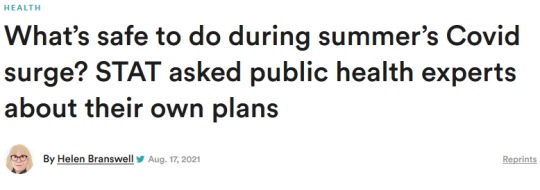

With Covid-19 cases and hospitalizations spiking around the country, dreams of a summer like those many us had in mind just a short time ago have faded.
The fully vaccinated have been told to resume wearing masks indoors. Companies and institutions are leveling vaccine mandates. And some municipalities are requiring people to show proof of vaccination to get into restaurants, bars, and gyms.
Confusion abounds about what is safe to do. (For the unvaccinated, there’s no confusion about what’s most important to do: Get immunized.)
To try to cut through the fog, STAT contacted three dozen epidemiologists, immunologists, and other infectious disease experts around the country to see how they are navigating the risk of Covid in these uncertain times. Twenty-eight responded.
STAT didn’t ask these experts to explain how they would advise others. Rather, we asked them to answer 10 questions — saying yes, no or only if masked — about their own willingness to engage in various activities, assuming they were vaccinated.
Their answers suggest that, with the highly transmissible Delta variant spreading, caution prevails. Those who know viruses best aren’t buying many movie tickets, and most aren’t eating indoors in restaurants.
But in other ways, responses diverged. And at least one expert suggested that geography really does matter when it comes to his own comfort level. Naor Bar-Zeev, a statistical epidemiologist at Johns Hopkins Bloomberg School of Public Health, declined to respond to all but one of the questions, saying answers are highly dependent on the circumstances of a place.
“In a place where most people are unvaccinated, or otherwise at high risk, and where there is active transmission, I should act more conservatively and with greater caution, even though I am protected from disease,” he said. “In a place where most people are vaccinated, and there is low transmission, one can be more permissive.”
Let’s unpack their answers.
Of the questions, only one earned a unanimous response: “Would you send your unvaccinated child to school without a mask?”
“Lord, no,” Paul Offit, a pediatric infectious disease specialist at Children’s Hospital of Philadelphia, replied. “NO!!! As a parent and a pediatrician, that is a terrible idea,” wrote Andrew Pavia, chief of pediatric infectious diseases at the University of Utah.
None of 27 people who answered this question expressed a willingness to send an unvaccinated child to school without a mask. Carlos del Rio, a professor of epidemiology and global health at the Rollins School of Public Health at Emory University, said he’d withdraw an unvaccinated child from a school if it didn’t have a mask mandate.
Children under the age of 12 cannot yet be vaccinated as none of the vaccines has been authorized for use in this age group.
The other school-related question — “Would you send your vaccinated teen to school without a mask?” — drew almost as fervent a response, with 24 of 26 saying no.
Ellen Foxman, an immunologist at Yale University, was one of the exceptions. “Yes, if the high school had a high vaccination rate/low Covid transmission rate and my family had no high-risk personal contacts,” she wrote. “If the school required all students and staff to be vaccinated, I would have no problem whatsoever with no masks.”
Pavia gave a nuanced answer for his support for masks for vaccinated teens. “If the vaccinated kids don’t mask, the unvaccinated are unlikely to mask and there is a risk of bullying. Masks for all is much more likely to work,” he wrote.
Michael Osterholm, director of the University of Minnesota’s Center for Infectious Disease Research and Policy, said he not only wouldn’t allow a vaccinated teen to go to school without a mask, he’d demand the teen wear an N-95 respirator. Cloth face coverings aren’t enough to combat Delta, he insisted.
Shane Crotty, an immunologist at La Jolla Institute of Immunology, said he’d send teenagers to school with masks, but would be okay with them taking them off around friends outside of school or during an outdoor lunch break.
When the experts were asked whether they would eat indoors at a restaurant, responses were slightly more mixed. More than half of respondents said no, but six said they would, or would in off-peak hours, and three more said they would do it but would wear a mask when they weren’t eating.
Saad Omer, director of Yale’s Institute for Global Health, said he would eat indoors in a restaurant that required customers to show proof of vaccination. “I generally feel safe indoors in a restaurant as long as underlying community transmission is low and I’m eating with other vaccinated people,” wrote John Brownstein, an epidemiologist and chief innovation officer at Boston Children’s Hospital. “However, I always prioritize eating outside where possible.”
That approach no longer seems viable to Syra Madad, senior director for the special pathogens program in the NYC Health + Hospitals network. “More than 95% of Americans live in areas of high or substantial community transmission so it’s no longer a matter of ‘Yes, I’ll eat indoors if I’m in an area of low community transmission,’” she wrote.
It seems like we’re over DIY hair — or so the answers to the question of whether the experts would go to a hairdresser or a barber shop would suggest.
All but four respondents said they would go to a hair salon or barber at this point even if they didn’t know the vaccination status of other clients. And even one of the four more cautious respondents allowed that she might consider it. “No, but if we are all far apart and there are few people I might with a mask,” said Krutika Kuppalli, an infectious disease physician at the Medical University of South Carolina.
Most people who said yes did so with the caveat that they’d wear a mask. Jesse Goodman, a professor of medicine at Georgetown University, said he would go only if he and everyone else in the place was masked. Akiko Iwasaki, a Yale University immunologist, said she would try to reduce the frequency of visits. But Jeanne Marrazzo, director of the division of infectious diseases at the University of Alabama in Birmingham, was in favor of professional hair care in general.
“I know how careful my hairdresser has been,” Marrazzo wrote. “She also needs financial support; my hair also needs it.”
Would the experts go to the theater to see a film? Seventeen said no.
“Non-essential,” said Shweta Bansal, whose Georgetown University laboratory studies how social behavior affects infectious disease transmission.
Florian Krammer, an immunologist at the Icahn School of Medicine at Mount Sinai, in Manhattan, believes most people who are fully vaccinated are well protected at this point. He would go to see a movie wearing a mask.
Amesh Adalja, an infectious disease physician and a senior scholar at Johns Hopkins Center for Health Security, has a different view on Covid risks than some of the other people STAT polled. He (and others) believe Covid is going to become endemic — we’re going to have to learn to live with it. For fully vaccinated people, Adalja said, the risks even from contracting Covid are pretty low.
“That fact makes me comfortable as a fully vaccinated individual without underlying health problems to resume my pre-pandemic life because I am risk-tolerant and I know that if I am to get a breakthrough infection it is likely to be mild,” he said. Adalja said yes to all but two of STAT’s questions; he would not send an unvaccinated child to school without a mask and would not currently give a second dose of the Johnson & Johnson vaccine.
William Hanage, an epidemiologist in Harvard’s T.H. Chan School of Public Health, said he’d happily skip going to the movies, but his wife enjoys going. So he would go, wearing a mask.
There was almost an even split among the experts to the question of whether they would attend a large outdoor concert or sporting event, with a slight edge going to the “yes” side. Most of the 15 people said they’d do it if masked.
Robert Wachter, the chair of the University of California, San Francisco’s department of medicine, said he’d don a mask “if shouting people [were] at very close range.” Jason Salemi, an epidemiologist at the University of South Florida, said he “would not attend a large outdoor concert right now,” stressing the amount of Covid transmission in his state at the moment.
Move a mass gathering indoors and the answers shift. In response to the question of whether they would go to an indoor wedding or other religious service — one where they did not know the vaccination status of the other attendees — more of the experts said no.
Saskia Popescu, an infectious disease specialist and assistant professor in George Mason University’s biodefense program, for instance, would go to an outdoor concert or sporting event, masked. Even with a mask, she would not attend an indoor wedding or religious ceremony.
Emergency physician Uché Blackstock, founder and CEO of the consulting firm Advancing Health Equity, said she’d forgo indoor and outdoor large gatherings at this point.
We asked two questions about travel: “Would you travel to a part of the United States experiencing a surge in Covid cases?” and “Would you go on a non-essential international trip?” Surprisingly, there was slightly more willingness in the group to travel internationally than to domestic Covid hot spots.
In response to the former, Peter Hotez was succinct. “I’m living it,” said the Hotez, co-director of the Texas Children’s Center for Vaccine Development, based in Houston-swamped Covid-19.
Del Rio, who lives in Atlanta, goes frequently to Miami to visit his son and his son’s family. “I am very careful when I travel,” he said. Since the pandemic began he has twice visited his mother in Mexico, “but at this point I am not going. May go later in the year,” he wrote.
Carl Bergstrom, an evolutionary biologist at the University of Washington, said he wouldn’t travel abroad now. Not because of Covid directly, but because he might get stuck somewhere if travel restrictions were instituted. Hanage and his family vacationed on Cape Cod this year instead of taking a planned trip to Iceland, for the same reason.
Nahid Bhadelia, director of Boston University’s Center for Emerging Infectious Diseases Policy & Research, said she would not travel to an American Covid hot zone if she could avoid it, but would travel internationally, if her destination had a high vaccination rate and a low transmission rate.
Angela Rasmussen, a coronavirus virologist at the University of Saskatchewan’s Vaccine and Infectious Disease Organization, said she would travel to a location in the U.S. having an upswing in Covid transmission, but would do it using precautions. As for international travel, “depends where, but masked,” she said.
Our final question was for the physicians in the group was this: “Would you recommend that patients who received the one-dose J&J vaccine get another dose of vaccine?”
Crotty, the immunologist at La Jolla Institute of Immunology, said yes; he tweeted recently about his support for giving J&J recipients an extra dose of vaccine to cope with the Delta variant. “I have had physicians emailing me thanks about my [Twitter] threads on this,” he said.
Megan Ranney, an emergency physician at Lifespan Health System in Providence, R.I., said she’s waiting for guidance from the Food and Drug Administration. “But in the meantime, I certainly wouldn’t judge anyone who does get another dose.”
And Helen Keipp Talbot, a vaccine researcher at Vanderbilt University, pleaded the Fifth. Talbot is a member of the Advisory Committee on Immunization Practices, which advises the CDC on vaccination policy. “No comment,” was her reply.
***
About the Author: Helen Branswell
Senior Writer, Infectious Disease
Helen covers issues broadly related to infectious diseases, including outbreaks, preparedness, research, and vaccine development.
@HelenBranswell
***
source: https://www.statnews.com/2021/08/17/whats-safe-to-do-during-summers-covid-surge-stat-asked-public-health-experts-about-their-own-plans/
63 notes
·
View notes
Text
Felipe & Letizia’s decade: Trips Abroad
F&L Decade 61/??
King Felipe and Queen Letizia paid an Official Visit to Washington, DC and Florida, USA, between September 15 and 18, 2015. They were accompanied by the Minister of Foreign Affairs and Cooperation, José Manuel García-Margallo. During the visit, among other activities, they met with President Obama and his wife and They joined the 450th anniversary of Saint Augustine, the oldest American city of European origin.
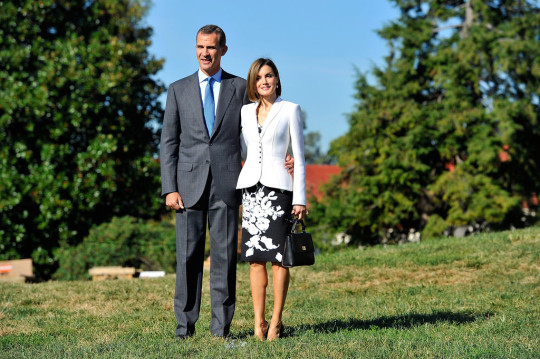
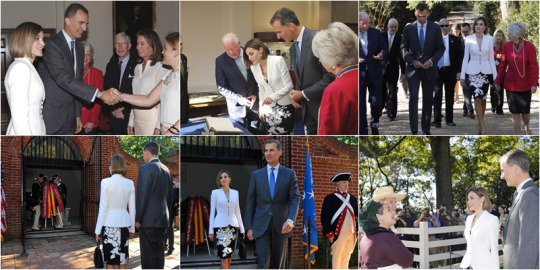
On the 15th, Their Majesties the Kings began activities in Mount Vernon. Don Felipe and Doña Letizia visited the pantheon and the residence of President George Washington. The Kings made a wreath in the pantheon and had the opportunity to greet the volunteers, dressed in period costume, from the Louisiana Fixed Infantry Regiment.
Next, they headed to the Fred W. Smith National Library for the Study of George Washington. The Kings accessed the rooms that house George Washington's personal library, made up of 900 volumes, and viewed various manuscripts and outstanding books owned by the first American president, such as two old editions of "Don Quixote." Don Felipe and Doña Letizia presented, as a donation to this institution, a reproduction of the Credential Letters of the first Ambassador of the United States of America in Spain, addressed to Carlos IV and signed by George Washington.
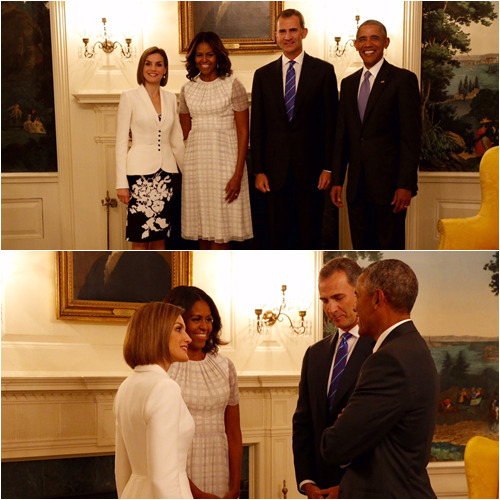
Later, Don Felipe and Doña Letizia visited the White House, where they were received by the President of the United States of America, Barack Obama, and his wife, the First Lady, Michelle Obama.
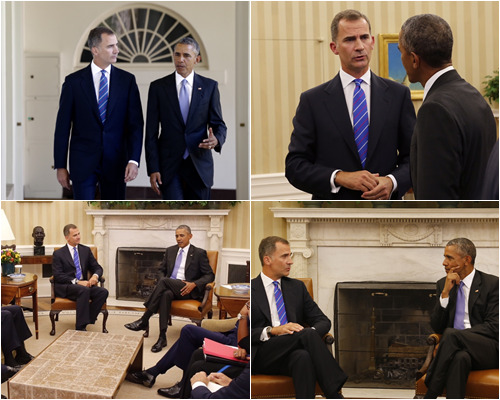
His Majesty the King and President Obama held a meeting in the Oval Office of the White House. At their conclusion, they offered the media a few brief statements.

Meanwhile, Doña Letizia and Mrs. Obama met in the private residence and visited the garden-orchard of the White House, within the initiative of the First Lady "Let's move", which aims to promote good eating habits.
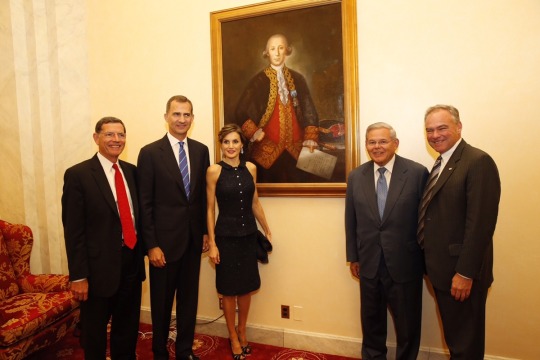
In the afternoon, the Kings attended the Congress of the United States of America to hold a meeting with the Senate Foreign Affairs Committee, in which they discussed various international policy issues. The day ended with a reception for a representation of the Spanish community in Washington, which was attended by nearly two hundred attendees.
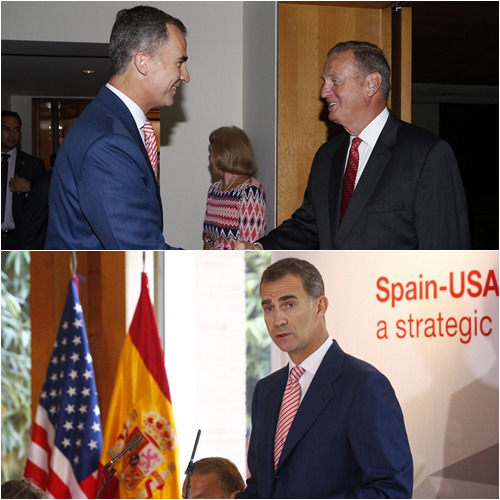
On September 16, His Majesty the King held a working breakfast with American businessmen at the Residence of the Spanish Ambassador, organized by the ICEX-Invest in Spain and the Economic and Commercial Office of the Spanish Embassy in the United States, in collaboration with the US Chamber of Comerce, in which representatives of companies such as DuPont, Dow Chemicals, Costco, Lilly, Microsoft, HP, 3M, Honeywell, Marriott, UPS, IP were present Containers or General Motors.
Don Felipe pointed out that there is still a lot of potential to be discovered in the economic relations between both countries and that now is a good time to consider investing in Spain.
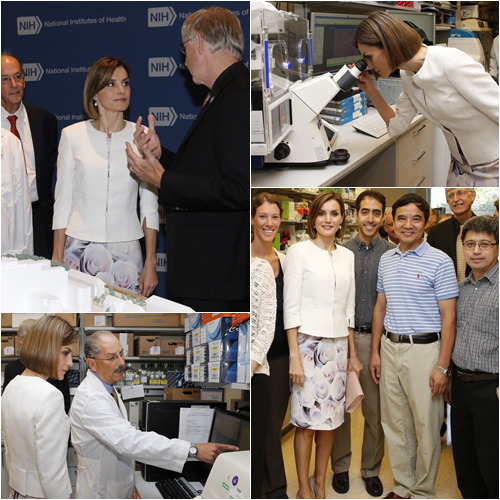
In parallel, Her Majesty the Queen visited the National Cancer Institute at the Clinical Hospital of the National Institutes of Health (NIH). After learning about the research laboratories of the pediatric cancer-fighting unit, Doña Letizia held a working meeting.
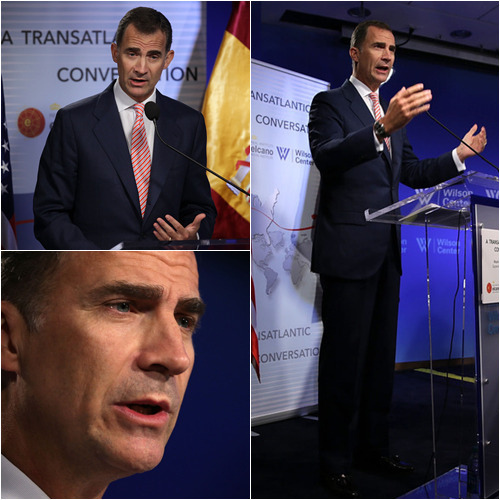
Later, at the Ronald Reagan Building and International Trade Center, the King attended the seminar "A transatlantic conversation", organized by the Wilson Center and the Royal Elcano Institute. In his speech, the King referred to the need to address global challenges, such as climate change, nuclear proliferation and global terrorism, through global solutions.
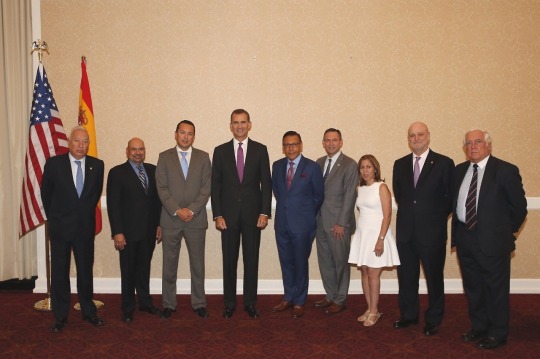
At noon, Don Felipe held a working lunch with scientists and experts participating in the seminar, and then met with a group of young Hispanic leaders in the United States.
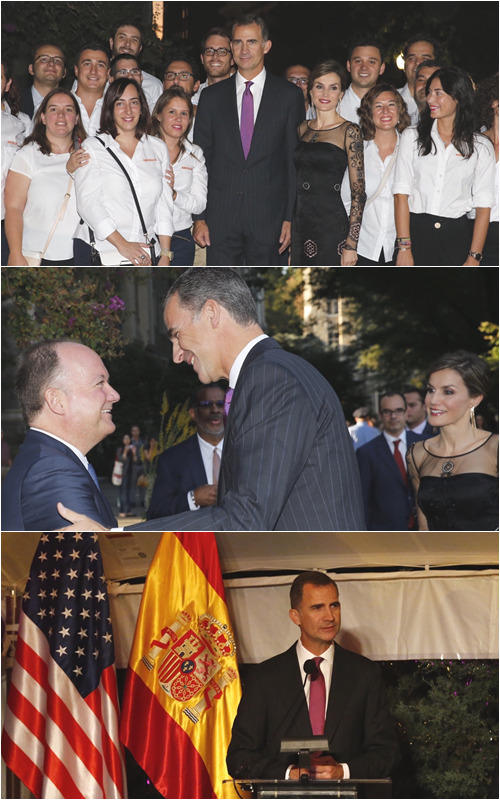
In the evening, Their Majesties the Kings attended the presentation ceremony of the First Meeting of Spanish Scientists in the United States at Georgetown University. This initiative, promoted by the Prince of Asturias Chair of this academic institution, aims to forge and strengthen links between scientists, explore new opportunities for interdisciplinary collaboration, create a forum for discussion and reflection on the current state of scientific disciplines and their advances and build bridges that facilitate communication between the Spanish scientific community in the USA. and public and private organizations in both countries.
"The professionals of the Spanish Science are essential actors in this scientific and social gear, and protagonists of innovation and technical knowledge. You are social references for the vocation of our young people and true architects to build solid bridges between generations of scientists. You are example of talent and perseverance, shows the strengths of our educational system, ambassadors of our culture, as well as a very valuable connector between our internal scientific and technological capacities and the networks of knowledge and innovation on a global scale," Don Felipe told the scientists .
The day ended with a dinner offered in honor of Their Majesties the Kings by Georgetown University. In his toast, Don Felipe took stock of the enrichment that the relations between Spain and the United States have experienced in the twenty years that have passed since his graduation: "I am proud to see that Spanish companies invest more in the United States than American companies in Spain and they employ more than 80,000 Americans. It is also great to see Spain as the second preferred destination outside the continent for American students. We receive almost 25,000 each year. Let me also tell you that Spanish is the second most spoken language in the The United States, as well as the second language for international communication throughout the world. Finally, I must emphasize that our friendship as nations and peoples has grown strongly. Today, Spain and the United States are more united than ever, not only in the NATO, and facing new challenges together."
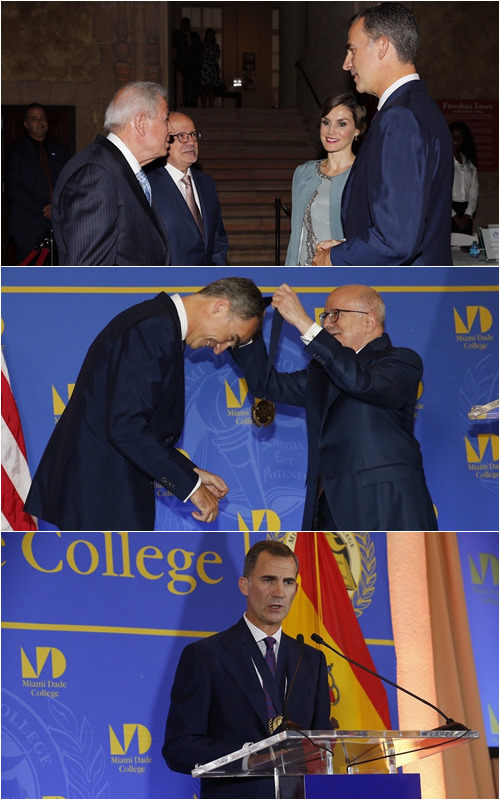
On the 17th, Their Majesties the Kings traveled to Florida. In the afternoon, in the Freedom Tower-headquarters of the main auditorium of Miami Dade College-, the president of Miami Dade College imposed the Presidential Medal of the academic center on Don Felipe.
Subsequently, His Majesty the King gave the inaugural conference for the 2015-2016 academic year, entitled "The Spanish of the United States", where in Spanish and English, Don Felipe valued the importance of this language as a "substantial part" of the present of the United States and "cardinal component" of its future, reason why it defended the existence of "a Spanish of the United States", with its own social and linguistic profile, in front of "the Hispanic you speak of other latitudes". He also stressed that "the Spanish of the USA cannot be understood as an autonomous variety, at the exclusive service of an interior community and isolated from other peoples with a common history, but as a manifestation of an international language enriched by endless modalities and accents from North and South America, the Caribbean and Africa, Europe and the Pacific. Homogeneity and, at the same time, the multiplicity of voices are the basis of the wealth of Spanish and its international projection " .

At the end of the conference, Their Majesties the Kings went to the Miami Dade College exhibition area. Don Felipe and Doña Letizia delivered a series of engravings on the life and work of Pedro Menéndez de Avilés - Asturian admiral who landed in 1565 on these coasts and named the place with the name of the patron saint of his native town (San Agustín) - , belonging to the Tegesta collection and made by the painter Amado González Hevia "Favila", and various books on the common history and relations between Spain and the United States.
A reception given by the president of Miami Dade College in honor of Their Majesties the Kings, ended the act.

The day concluded with the attendance at the presentation of the Spanish Film Festival "Recent Cinema from Spain", at the Olimpia Theater in Miami, where the film "Cándida" was shown. This festival, created in 2011 and promoted by the Audiovisual Producers Rights Management Entity (EGEDA), opens a new space for the promotion of Spanish cinema in the US, both among the general public and before the international audiovisual industry , with a genre-rich cinematography that easily connects with the American audience, especially the Latin one.

On the 18th, Don Felipe and Doña Letizia visited the city of San Agustín on the occasion of the 450th anniversary of its foundation. They began their tour of the Castillo de San Marcos, which continued through the Lightner Museum. The Kings signed there in the book of honor of San Agustín and delivered to the city a painting by Pedro Menéndez de Avilés made by the painter Amado González Hevia "Favila".

Then they went to the Government House. From the balcony, Don Felipe addressed a few words to the citizens gathered in the square, in which he referred to the deed of Pedro Menéndez de Avilés and joined the celebration of the 450th anniversary of the city. He also recalled the brotherhood of San Agustín with Avilés and the island of Menorca. "It is something that we can be proud of, both Spanish and American, united as we are by an inspiring past and a promising future as friends and allies," said the King.

Later, the Kings went to the Cathedral Basilica of San Agustín, where a short prayer of blessing and dedication of the bells of the Basilica to the Spanish Crown was held. After this visit, the mayor of San Agustín offered a lunch in honor of Their Majesties the Kings at Flagler College. In his speech, Don Felipe asked to take advantage of the 450th anniversary commemorations of the city of San Agustín "to shed light, more than on the characters and on the facts, on what they mean: the transmission of a culture that today permeates the entire American reality and that grows green day by day thanks to the more than fifty million Hispanics who today reside, work, integrate and commit to the future of the United States. "
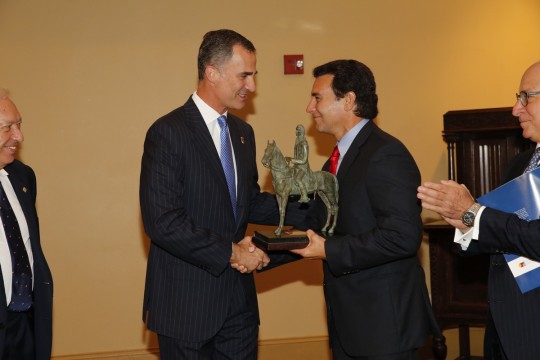
In the afternoon, the King presented the Bernardo de Gálvez Prize to Ford's President and CEO, Mark Fields, at the Casa Mónica hotel. With this annual award, the Spain-United States Council Foundation intends to honor and publicize the work of those persons or institutions, of American nationality who, with their work, example or dedication, have promoted cooperation between Spain and the United States. Together, they have improved reciprocal knowledge and the respective images or have developed any initiative that has resulted in progress and increased relations between the two societies.
Don Felipe then met with the Governor of Florida, Rick Scott, to whom he presented, as a donation, the sculpture "The passage to a new world: the foundation of Saint Augustine by Pedro Menéndez de Avilés".
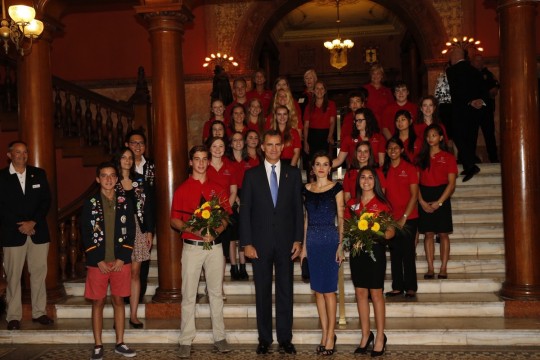
Subsequently, Their Majesties the Kings returned to Flagler College to attend the opening dinner of the XX Spain-United States Forum, organized by the Spain-United States Council Foundation and its United States counterpart, the United States – Spain Council. These meetings bring together their respective members each year and have the participation of leaders from the public and private sectors of both countries to address different issues of common interest. Among the topics addressed in its sessions, those related to business and financial promotion stand out, as well as analyzes of certain economic sectors (infrastructure, transport, technology, finance or energy, among others). Other issues are also debated such as the situation of triangulation relations between Spain, the United States and Latin America, the economic and cultural dimension of the Spanish language or the situation of the thriving Hispanic communities.
After this act, Their Majesties the Kings undertook their return to Spain.
#King Felipe#Queen Letizia#King Felipe of Spain#Queen Letizia of Spain#King Felipe VI#King Felipe VI of Spain#F&L Decade#Mine
5 notes
·
View notes
Photo

eAutoCollision: Auto Body Shop 8027-8029 Foster Avenue Brooklyn NY 11236 (718) 517-9180
https://www.eautocollision.com https://g.page/auto-body-shop-nyc/
Facebook
Twitter
Linkedin
Instagram
Youtube
Tumblr
Pinterest
Working Hours: Mon-Sat 8:00am - 6:00pm; Sun - closed Payment: cash, check, credit cards.
Trusted since 1999 to keep you and your family safe, eAutoCollision.com is the highest rated auto body repair shop in all five New York City boroughs. When it comes to high-performance vehicles, fleet services and preventative maintenance, there’s none better. The technicians at eAutoCollision are highly trained experts qualified to work on everything from heavy-duty trucks to electric cars. Their specialized auto body paint shop is incomparable, providing speedy quality paint jobs and touchups. From tune-ups to tire sales, you get it all at eAutoCollision. Call today to see what a difference it makes.
Where Can I Find a Trustworthy Car Mechanic in New York City? If you’re looking for an auto collision center in Brooklyn to handle the maintenance of your car, truck or SUV, your best option is eAutoCollision.com. In business since 1999, the Brooklyn vehicle repair shop employs recognized experts in auto repair. They’re also recognized as the best car paint shop in Manhattan, the Bronx, Queens, Staten Island or Brooklyn.
They take pride in their expert work on foreign and domestic vehicles. They can service your vehicle from start to finish, whether you need:
To get your vehicle up and running after a mechanical failure Auto body work after an accident Preventive maintenance to keep your vehicle in top condition What Does eAutoCollision’s Comprehensive Vehicle Repair Shop Offer? When you entrust the care of your vehicle to eAutoCollision, you’ll learn that they provide free estimates that they never exceed without your permission. Their technicians that have the tools, equipment and expertise needed to handle all types of repairs, large or small. They’re your dealer alternative, offering fast service at a better price than most dealerships. They specialize in computer programming and computerized scanning on most cars, including:
All personal and fleet vehicles Hybrids Electric vehicles Whether your car won’t start, is running rough or needs a New York State inspection, technicians certified by original equipment manufacturers (OEM) and the National Institute for Automotive Service Excellence (ASE) provide comprehensive auto repair services that include:
Diagnosing warning lights Transmission repair Muffler and exhaust repair Belts and hoses check
Auto electric repair Steering and suspension repair Ensuring your vehicle starts every time Electrical system repair Brake repair services Tire repair Tire replacement
Auto collision experts
Nearby Areas
Canarsie | East Flatbush | Georgetown | Flatlands | Brownsville
11236 | 11203 | 11234 | 11212, 11233
Keywords: auto collision nyc, auto collision center nyc, auto collision center brooklyn, auto collision center, auto collision brooklyn, auto body shop repair, auto body shop nyc
Find us: tupalo.co
#Auto electric repair#auto collision nyc#auto collision center nyc#auto collision brooklyn#auto repair#car scratch repair
1 note
·
View note
Text

🚨MOBILE MECHANIC🚨
☎️ 859-797-2233 ☎️
🔵 OPEN 24/7 🔵
Servicing Kentucky Lexington,Frankfort,Georgetown, Louisville, Paris, Sadieville, Richmond, Cynthiana, Brea, Lawrenceburg, & more
Brakes, water pump, alternator, wheel bearings, semi truck and trailers, emergency roadside repair, diesel repair on site repair,
Servicing Kentucky Lexington,Frankfort,Georgetown, Louisville, Paris, Sadieville, Richmond, Cynthiana, Brea, Lawrenceburg, & more
Brakes, water pump, alternator, wheel bearings, semi truck and trailers, emergency roadside repair, diesel repair on site repair, heavy equipment, tune up, cars, trucks, suv, mechanic that comes to me, mobile mechanic.
#mobilemechanic #859-797-2233 #kentucky #wecometoyou #cometoyoumechaic #wecometoyouanddoitall #servicingkentucky #open24/7 #lexingtonky #diesel #autorepair #carrepair #HireRush
Mobile Mechanic
mobile mechanic
Mobile Mechanic Lexington Kentucky
Mobile Mechanic Louisville Kentucky
Brakes
Rotors
Calipers
Brake lines
Master cylinder
Tensioner pulley
Serpentine belt
Timing belt
Timing chains
Valve cover gasket
Spark plugs
O2 sensors
Motor mounts
Shocks
Struts
Hub bearings
Tie rods
Ball joints
Upper Lower control arms
Sway bar & linkage
Alternators
Starters
Electrical issues
Radiators
Radiator hoses
Water pumps
Fuel pumps
AC compressors
AC Condenser
Expansion valve
Mufflers
Oil/water leaks
upgrades and custom work
Even Engines and Transmissions swaps
24-7 Emergency Repairs
Roadside Assistances
Auto Repair
#Mobile Car Repair Service
#Mobile Auto Repair Service
#Mobile Car Repairs
#Mobile Auto Repairs
#Mobile Car Repair
#Mobile Auto Repair
#Mobile Auto Mechanic
#Mobile Car Mechanic
#Auto Mechanic That Comes to You
#Auto Repair Shop
#Brakes and Traction Control
#Parking Brake Cable Replacement
#Parking Brake Switch Replacement
#Brake Master Cylinder Replacement
#Brake Safety Inspection
#Check Brake Fluid Level
#Brake Caliper Replacement
#Bleed Brakes
#Brake Fluid Flush
#Brake Booster Unit Replacement
#Brake Pads Replacement
#Brake Drum Replacement
#Brake Shoes Replacement
#Brake Pedal Linkage Lubrication
#Brake Adjustment
#Brake Rotor Replacement
#Brake Line Replacement
#Diagnostic
#Check Engine Light
#Car Won't Start
#Car Running Rough
#Fluids Are Leaking
#Warning Light
#Diagnostic
#Used Car Inspection
#Engine, Cooling, Exhaust
#Front Pipe Replacement
#Fan Shroud Assembly Replacement
#Idle Control Valve Replacement
#Fan Shroud Replacement
#Distributor Replacement
#EGR Valve Replacement
#Ignition Wire Set Replacement
#Cooling System Drain and Fill
#Oil Pan Gasket Replacement
#Intake Manifold Gasket Replacement
#Intake Camshaft Position Sensor Replacement
#Freeze Plug Replacement
#Exhaust Manifold Gasket Replacement
#Exhaust Camshaft Position Sensor Replacement
#Tail Pipe Replacement
#Carburetor Replacement
#Exhaust System Replacement
#Manual Transmission Oil Level Check
#Check Engine Oil Level
#Engine Oil and Filter Change
#Engine Mount Replacement
#Engine Coolant Temperature Sensor Replacement
#Engine Oil Pressure Sensor Switch Replacement
#Expansion Tank Replacement
#Harmonic Balancer Replacement
#Serpentine Belt Replacement
#Drive Belt Replacement
#Drive Belt Tensioner Replacement
#Distributor Cap Replacement
#Cooling Fan Replacement
#Radiator Replacement
#Radiator Fan Motor Replacement
#Radiator Hose Replacement
#Thermostat Replacement
#Engine Tune-up
#Water Pump Replacement
#Valve Cover Gasket Replacement
#Timing Belt Replacement
#Emissions Failure Repair
#Crankshaft Position Sensor Replacement
#Coolant Drain and Fill
#Catalytic Converter Replacement
#Camshaft Position Sensor Replacement Intake and Exhaust
#External Vehicle Parts
#Antenna Mast Replacement
#Mirror Glass Replacement
#Door Lock Replacement
#Headlight Door Replacement
#Header Panel Replacement
#License Plate Bracket Replacement
#Emblem Replacement
#Metal License Plate Bracket Replacement
#Trunk Strut Replacement
#Grille Insert Replacement
#Engine Splash Shield Replacement
#Fuel Tank Cap Replacement
#Hood Strut Replacement
#Splash Guard Backing Plate Replacement
#Rear Lift Gate Locking Mechanism
#Rear Distance Sensor Replacement
#Door Weather Stripping Replacement
#Power Seat Switch Replacement
#Energy Absorber Replacement
#Heating and Air Conditioning
#Blower Motor Resistor Replacement
#Heater Core Replacement
#Cabin Air Filter Replacement
#Heater and A/C Blower Motor
#A/C Recharge
#A/C Compressor Replacement
#A/C Condenser Replacement
#Defroster Grid Repair
#A/C Line or Hose Replacement
#Heater Core Hoses Replacement
#HVAC Electronic Control Module Replacement
#HVAC Blower Motor Resistor Replacement
#HVAC Blower Motor Replacement
#HVAC Blend Door Actuator Replacement
#A/C Evacuate and Recharge
#Lighting and Horns
#Turn Signal Switch Replacement
#Turn Signal Bulb Replacement
#Brake Light Bulb Replacement
#Headlight Bulb Replacement
#Fog Light Assembly Replacement
#Corner Light Bulb Replacement
#Side Marker Light Assembly Replacement
#Turn Signal Light Assembly Replacement
#Headlight Assembly Replacement
#Park Light Assembly Replacement
#Headlight Cover
#Tail Light Bulb Replacement
#Tail Light Assembly Replacement
#Brake Light Switch Replacement
#Headlight Switch
#Maintenance
#Fuse Replacement
#Tire Rotation
#Scheduled Maintenance - 30K, 60K, 90K, etc.
#Powertrain
#Throttle Body Replacement
#Throttle Position Sensor Replacement
#Oxygen Sensor Replacement
#Fuel Injector Replacement
#Fuel Filter Replacement
#Air Filter Replacement
#Mass Airflow Sensor/Meter Replacement
#Fuel Pressure Regulator Replacement
#Ignition Coil Replacement
#Spark Plugs Replacement
#Starting and Charging
#Ignition Switch Replacement
#Battery Replacement
#Battery Cable Replacement
#Battery Cable Terminal End Service
#Alternator Belt Replacement
#Alternator Replacement
#Starter Replacement
#Steering and Suspension
#Power Steering Hose Replacement
#Power Steering Fluid Drain and Fill
#Outer Tie Rod End Replacement
#Power Steering Pump Replacement
#Wheel Hub Assembly Replacement
#suspension-control-arm-replacement
#Check Tire Pressure
#Check Power Steering Fluid
#Power Steering Fluid Replacement
#Wheel Bearing Replacement
#ABS Control Unit Replacement
#Wheel Cylinder Replacement
#Ball Joint Replacement
#Shock Absorber Replacement
#Strut Assembly Replacement
#Transmission and Drivetrain
#Axle Assembly Replacement
#CV Joint Boot Replacement
#CV Joint Replacement
#CV Axle Assembly Replacement
#Driveshaft Replacement
#Transfer Case Fluid Replacement
#Transmission Fluid Change
#Windows and Glass
#Window Regulator with Motor Replacement
#Window Belt Strip Replacement
#Power Window Switch Replacement
#Wiper and Washer System
#Windshield Wiper Motor Replacement
#Windshield Wiper Blades Replacement
#Washer Pump Replacement
1 note
·
View note
Link
A Free, Open Resource for the Global Research Community
In response to the COVID-19 pandemic, the Allen Institute for AI has partnered with leading research groups to prepare and distribute the COVID-19 Open Research Dataset (CORD-19), a free resource of over 51,000 scholarly articles, including over 40,000 with full text, about COVID-19 and the coronavirus family of viruses for use by the global research community.
This dataset is intended to mobilize researchers to apply recent advances in natural language processing to generate new insights in support of the fight against this infectious disease. The corpus will be updated weekly as new research is published in peer-reviewed publications and archival services like bioRxiv, medRxiv, and others.
CORD-19 Explorer is a quick and easy way to search the CORD-19 corpus, and CoViz allows you to discover associations between concepts appearing in the dataset. Or, get started by downloading the complete data below.
Participate in the CORD-19 Challenge
Kaggle is hosting the COVID-19 Open Research Dataset Challenge, a series of important questions designed to inspire the community to use CORD-19 to find new insights about the COVID-19 pandemic including the natural history, transmission, and diagnostics for the virus, management measures at the human-animal interface, lessons from previous epidemiological studies, and more.
Download CORD-19
By downloading this dataset you are agreeing to the Dataset License. Specific licensing information for individual articles in the dataset is available in the metadata file.
Additional licensing information is available on the PMC website, medRxiv website and bioRxiv website.
Download here: https://pages.semanticscholar.org/coronavirus-research
Latest release contains papers up until 2020-04-10 with over 40,000 full text articles. (Changelog from previous release.)
Commercial use subset (includes PMC content) 350Mb:
Non-commercial use subset (includes PMC content) 73MB:
Custom license subset (includes PMC, Elsevier content) 630MB:
bioRxiv/medRxiv subset (pre-prints that are not peer reviewed) 22Mb:
Metadata file -- 74Mb (with Microsoft Academic ID mapping)
CAS COVID-19 Anti-Viral Candidate Compounds (description - dataset provided by CAS, a division of the American Chemical Society)
Paper embeddings (API)
Readme
PDF - 9524 full text (new: 174, removed: 15)
PMC - 9148 full text (new: 174, removed: 21)
PDF - 2490 full text (new: 130, removed: 17)
PMC - 2217 full text (new: 128, removed: 4)
PDF - 26505 full text (new: 3647, removed: 294)
PMC - 7802 full text (new: 3081, removed: 52)
PDF - 1625 full text (new: 353, removed: 70)
Each paper is represented as a single JSON object. The schema is available here and previous versions of the dataset are available here.
Description:
The dataset contains all COVID-19 and coronavirus-related research (e.g. SARS, MERS, etc.) from the following sources:
PubMed's PMC open access corpus using this query (COVID-19 and coronavirus research)
Additional COVID-19 research articles from a corpus maintained by the WHO
bioRxiv and medRxiv pre-prints using the same query as PMC (COVID-19 and coronavirus research)
We also provide a comprehensive metadata file of 51,078 coronavirus and COVID-19 research articles with links to PubMed, Microsoft Academic and the WHO COVID-19 database of publications (includes articles without open access full text).
We recommend using metadata from the comprehensive file when available, instead of parsed metadata in the dataset. Please note the dataset may contain multiple entries for individual PMC IDs in cases when supplementary materials are available.
This repository is linked to the WHO database of publications on coronavirus disease and other resources, such as Microsoft Academic Graph, PubMed, and Semantic Scholar. A coalition including the Chan Zuckerberg Initiative, Georgetown University’s Center for Security and Emerging Technology, Microsoft Research, and the National Library of Medicine of the National Institutes of Health came together to provide this service. We also thank and acknowledge Unpaywall for providing open access license information for portions of the dataset.
Citation:
When including CORD-19 data in a publication or redistribution, please cite the dataset as follows:
In bibliography:
COVID-19 Open Research Dataset (CORD-19). 2020. Version 2020-03-20. Retrieved from https://pages.semanticscholar.org/coronavirus-research. Accessed YYYY-MM-DD. doi:10.5281/zenodo.3715505
In text:
(CORD-19, 2020)
The Allen Institute for AI and particularly the Semantic Scholar team will continue to provide updates to this dataset as the situation evolves and new research is released.
Contribute to CORD-19
To maximize impact and increase full text available to the global research community, we are actively encouraging publishers to make their research content openly available for AI projects like this that benefit the common good.
If you’re a publisher interested in contributing to the CORD-19 corpus, please contact [email protected].
Join the active discussion and share ideas in the CORD-19 forum.
For research inquiries, please contact Kyle Lo ([email protected]) and Lucy Lu Wang ([email protected]). For inquiries regarding CoViz and knowledge discovery, please contact Tom Hope ([email protected]).
Resources from the Allen Institute for AI
CoViz: tool for exploring associations between concepts appearing in CORD-19
CORD-19 Explorer: full-text search engine
SciSpacy: a text processing toolkit optimized for scientific text
SciBERT: a BERT model pretrained on scientific text
Semantic Scholar API
Semantic Scholar Open Research Corpus
Create an AI-powered customizable adaptive feed of COVID-19 research
View the latest search results for COVID-19 on Semantic Scholar
Additional Resources
COVID-19 Research Database (provided by the WHO)
LitCOVID (provided by the NIH)
COVID-19 Resource Page and CORD-19 AI Powered Search (provided by Microsoft)
COVID-19 Research Export File (provided by Dimensions)
Day-Level COVID-19 Dataset (hosted on Kaggle)
COVID-19 Global Cases (provided by Johns Hopkins University)
COVID-19 Open Patent Dataset (hosted by Lens.org)
COVID-19 Global Rheumatology Registry (provided by the Global Rheumatology Alliance)
COVID-19 Literature Review Collection (hosted by Cochrane Library)
CORD-19 Search Engine (provided by Verizon Media)
COVID-19 Policy Dataset (provided by Overton)
COVID-19 DOC Search Engine and Resource Page (provided by Doctor Evidence)
COVID-19 Clinical Trials Tracker (provided by TranspariMED)
ASReview - Active learning for Systematic Reviews (provided by Utrecht University)
Blog Post: Computer Scientists Are Building Algorithms to Tackle COVID-19
Go here for more...
Publisher Resources
American Society for Microbiology
BMJ
Elsevier (Coronavirus Research Repository)
New England Journal of Medicine
SAGE
Springer Nature
Wiley
Compute Resources
AWS Resources and programs supporting COVID-19 research:
AWS Diagnostic Development Initiative Web Portal
Registry of Open Data on AWS, COVID-19 Open Research Dataset (CORD-19)
Please contact us [email protected] if you’d like to request to add other resources.
2 notes
·
View notes
Text
Preventive Maintainance in Austin Texasmore information is at : http://mobilemechanicsaustin.com/preventive-maintainance-near-me/Are you looking for Preventive Maintainance In Austin Texas? Austin Mobile Mechanic Service provides the Preventive Maintainance in the whole town. Our professional team with their skilled techniques and complete knowledge provides the services which are needed by customers. Whether you are stuck in the mid of the road or you are in an emergency and you need Preventive Maintainance then you can call us. Well, for the Preventive Maintainance , we can provide you the best team for the services. For free estimates, contact us or book an appointment now. REQUEST FREE ESTIMATES Preventive Maintainance in Austin Mobile Mechanic Service We are proud of our team. Each mechanic at Austin Mobile Mechanic Service is meticulous in their work. We take pride in serving our clients from Austin Texas. That includes major hubs like Irving, Farmers Branch, Carrollton, and Plano. With our mobile fleet and truck services, we are able to come to you. This includes many preventative maintenance services. From brakes to steering and suspension maintenance, our team does it all. We will fill your tires with nitrogen so that they expand and contract less with hot Texas temperatures. We’ll give your engine a tune-up and work on your muffler and exhaust systems so that your truck drives more smoothly and economically. We work on transmissions and clutches so that you can take on different terrains and highways. Each service that we provide is designed to ensure that your truck stays on the road, not in the shop. PREVENTIVE MAINTAINANCE IN AUSTIN TEXASAUSTIN MOBILE MECHANIC SERVICEREQUEST MORE INFORMATION. CLICK HERE!OR CALL US!Service AreaAnderson Mill, TX Austin TX Barton Creek, TX Barton Hills, TX Bee Cave, TX Briarcliff, TX Brushy Creek, TX Cedar Creek, TX Cedar Park, TX Clarksville, TX Driftwood, TX Dripping Springs, TX Elgin, TX Georgetown, TX Granger, TX Hudson Bay, TX Hutto, TX Jollyville, TX Kyle, TX Lago Vista, TX Lakeway, TX Leander, TX Liberty Hill, TX Lost Creek, TX Manor, TX North Austin, TX NW Hills, TX Oak Hill, TX Pflugerville, TX Point Venture, TX Rollingwood, TX Round Rock, TX South Austin, TX Spicewood, TX Steiner Ranch, TX Taylor, TX The Hills, TX Travis Heights, TX West Lake Hills, TX Windemere, TX Wyldwood, TXZip Codes in Austin, Texas:76527 (Florence) 76530 (Granger) 76537 (Jarrell) 76573 (Schwertner) 76574 (Taylor) 76578 (Thrall) 78602 (Bastrop) 78610 (Buda) 78612 (Cedar Creek) 78613 (Cedar Park) 78615 (Coupland) 78616 (Dale) 78617 (Del Valle) 78619 (Driftwood) 78620 (Dripping Springs) 78621 (Elgin) 78622 (Fentress) 78626 (Georgetown) 78628 (Georgetown) 78633 (Georgetown) 78634 (Hutto) 78640 (Kyle) 78641 (Leander) 78642 (Liberty Hill) 78644 (Lockhart) 78645 (Lago Vista) 78648 (Luling) 78650 (Mc Dade) 78652 (Manchaca) 78653 (Manor) 78655 (Martindale) 78656 (Maxwell) 78659 (Paige) 78660 (Pflugerville) 78661 (Prairie Lea) 78662 (Red Rock) 78664 (Round Rock) 78665 (Round Rock) 78666 (San Marcos) 78669 (Spicewood) 78676 (Wimberley) 78681 (Round Rock) 78701 | 78702 | 78703 | 78704 | 78705 | 78712 | 78717 | 78719 | 78721 | 78722 | 78723 | 78724 | 78725 (Hornsby Bend) 78726 | 78727 | 78728 (Wells Branch) 78729 (Jollyville) 78730 | 78731 | 78732 | 78733 | 78734 (Lakeway) 78735 | 78736 | 78737 | 78738 (Bee Cave) 78739 | 78741 | 78742 | 78744 | 78745 | 78746 | 78747 | 78748 | 78749 | 78750 | 78751 | 78752 | 78753 | 78754 | 78756 | 78757 | 78758 | 78759 | 78953 (Rosanky) 78957 (Smithville)
0 notes
Text
Are you looking for Transmission Repair In Austin Texas? more information is at: https://mobiletruckrepairaustin.com/transmission-repair-near-me/ Mobile Truck Repair Austin provides Transmission Repair in the whole town. Our professional team with their skilled techniques and complete knowledge provides the services which are needed by customers. Whether you are stuck in the middle of the road or in emergency and need Transmission Repair , you can call us. Well, for the Transmission Repair , we can provide you with the best team for the services. For free estimates, contact us or book an appointment now. REQUEST FREE ESTIMATES Transmission Repair in Mobile Truck Repair AustinIf you need transmission repair services, the team at Mobile Truck Repair Austin is available around the clock to help. No job is too big or small for us to handle and we’re looking forward to meeting – and exceeding – your expectations for service. TRANSMISSION REPAIR IN AUSTIN TEXAS MOBILE TRUCK REPAIR AUSTIN REQUEST MORE INFORMATION. CLICK HERE! OR CALL US!SERVICE AREA OUR SERVICE AREA Anderson Mill: TX Austin TX Barton Creek, TX Barton Hills, TX Bee Cave, TX Briarcliff, TX Brushy Creek, TX Cedar Creek, TX Cedar Park, TX Clarksville, TX Driftwood, TX Dripping Springs, TX Elgin, TX Georgetown, TX Granger, TX Hudson Bay, TX Hutto, TX Jollyville, TX Kyle, TX Lago Vista, TX Lakeway, TX Leander, TX Liberty Hill, TX Lost Creek, TX Manor, TX North Austin, TX NW Hills, TX Oak Hill, TX Pflugerville, TX Point Venture, TX Rollingwood, TX Round Rock, TX South Austin, TX Spicewood, TX Steiner Ranch, TX Taylor, TX The Hills, TX Travis Heights, TX West Lake Hills, TX Windemere, TX Wyldwood, TX Zip Codes: 76527 (Florence) 76530 (Granger) 76537 (Jarrell) 76573 (Schwertner) 76574 (Taylor) 76578 (Thrall) 78602 (Bastrop) 78610 (Buda) 78612 (Cedar Creek) 78613 (Cedar Park) 78615 (Coupland) 78616 (Dale) 78617 (Del Valle) 78619 (Driftwood) 78620 (Dripping Springs) 78621 (Elgin) 78622 (Fentress) 78626 (Georgetown) 78628 (Georgetown) 78633 (Georgetown) 78634 (Hutto) 78640 (Kyle) 78641 (Leander) 78642 (Liberty Hill) 78644 (Lockhart) 78645 (Lago Vista) 78648 (Luling) 78650 (Mc Dade) 78652 (Manchaca) 78653 (Manor) 78655 (Martindale) 78656 (Maxwell) 78659 (Paige) 78660 (Pflugerville) 78661 (Prairie Lea) 78662 (Red Rock) 78664 (Round Rock) 78665 (Round Rock) 78666 (San Marcos) 78669 (Spicewood) 78676 (Wimberley) 78681 (Round Rock) 78701 | 78702 | 78703 | 78704 | 78705 | 78712 | 78717 | 78719 | 78721 | 78722 | 78723 | 78724 | 78725 (Hornsby Bend) 78726 | 78727 | 78728 (Wells Branch) 78729 (Jollyville) 78730 | 78731 | 78732 | 78733 | 78734 (Lakeway) 78735 | 78736 | 78737 | 78738 (Bee Cave) 78739 | 78741 | 78742 | 78744 | 78745 | 78746 | 78747 | 78748 | 78749 | 78750 | 78751 | 78752 | 78753 | 78754 | 78756 | 78757 | 78758 | 78759 | 78953 (Rosanky) 78957 (Smithville)
0 notes
Text
Are you looking for Transmission Repair In Austin?
more information is at : http://a1mobilemechanicofaustin.com/transmission-repair-near-me/
A1 Mobile Mechanic of Austin provides the Transmission Repair in the whole town. Our professional team with their skilled techniques and complete knowledge provides the services which are needed by customers. Whether you are stuck in the mid of the road or you are in emergency and you need Transmission Repair then you can call us. Well, for the Transmission Repair, we can provide you the best team for the services. For free estimates, contact us or book an appointment now.
REQUEST FREE ESTIMATES
Transmission Repair in A1 Mobile Mechanic of Austin If you need transmission repair services, the team at A1 Mobile Mechanic of Austin is available around the clock to help. No job is too big or small for us to handle and we’re looking forward to meeting – and exceeding – your expectations for service.
TRANSMISSION REPAIR IN AUSTIN
A1 MOBILE MECHANIC OF AUSTIN
REQUEST MORE INFORMATION.
CLICK HERE!OR CALL US!
SERVICE AREA OUR SERVICE AREA Anderson Mill, TX Austin TX Barton Creek, TX Barton Hills, TX Bee Cave, TX Briarcliff, TX Brushy Creek, TX Cedar Creek, TX Cedar Park, TX Clarksville, TX Driftwood, TX Dripping Springs, TX Elgin, TX Georgetown, TX Granger, TX Hudson Bay, TX Hutto, TX Jollyville, TX Kyle, TX Lago Vista, TX Lakeway, TX Leander, TX Liberty Hill, TX Lost Creek, TX Manor, TX North Austin, TX NW Hills, TX Oak Hill, TX Pflugerville, TX Point Venture, TX Rollingwood, TX Round Rock, TX South Austin, TX Spicewood, TX Steiner Ranch, TX Taylor, TX The Hills, TX Travis Heights, TX West Lake Hills, TX Windemere, TX Wyldwood, TX 76527 (Florence) 76530 (Granger) 76537 (Jarrell) 76573 (Schwertner) 76574 (Taylor) 76578 (Thrall) 78602 (Bastrop) 78610 (Buda) 78612 (Cedar Creek) 78613 (Cedar Park) 78615 (Coupland) 78616 (Dale) 78617 (Del Valle) 78619 (Driftwood) 78620 (Dripping Springs) 78621 (Elgin) 78622 (Fentress) 78626 (Georgetown) 78628 (Georgetown) 78633 (Georgetown) 78634 (Hutto) 78640 (Kyle) 78641 (Leander) 78642 (Liberty Hill) 78644 (Lockhart) 78645 (Lago Vista) 78648 (Luling) 78650 (Mc Dade) 78652 (Manchaca) 78653 (Manor) 78655 (Martindale) 78656 (Maxwell) 78659 (Paige) 78660 (Pflugerville) 78661 (Prairie Lea) 78662 (Red Rock) 78664 (Round Rock) 78665 (Round Rock) 78666 (San Marcos) 78669 (Spicewood) 78676 (Wimberley) 78681 (Round Rock) 78701 | 78702 | 78703 | 78704 | 78705 | 78712 | 78717 | 78719 | 78721 | 78722 | 78723 | 78724 | 78725 (Hornsby Bend) 78726 | 78727 | 78728 (Wells Branch) 78729 (Jollyville) 78730 | 78731 | 78732 | 78733 | 78734 (Lakeway) 78735 | 78736 | 78737 | 78738 (Bee Cave) 78739 | 78741 | 78742 | 78744 | 78745 | 78746 | 78747 | 78748 | 78749 | 78750 | 78751 | 78752 | 78753 | 78754 | 78756 | 78757 | 78758 | 78759 | 78953 (Rosanky) 78957 (Smithville)
0 notes
Text
What does "deep cleaning" mean to have virus-free boats, planes and houses?
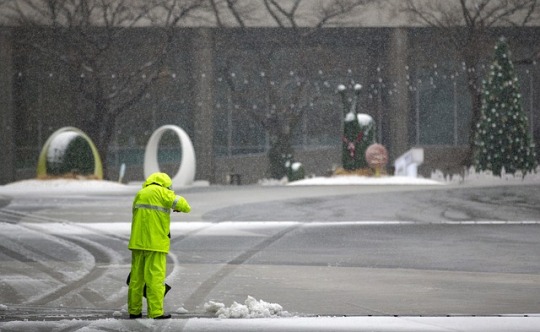
The Diamond Princess cruise ship. A Georgetown church in Washington, DC A Latino restaurant in Raleigh, North Carolina. A hotel in Oklahoma City. Two Broadway theaters in New York City.
All announced that they have undergone a "deep cleaning" in recent weeks to learn that at least one person infected with the new coronavirus had been in those places.
Be part of the Kaiser Health News Facebook group in Spanish “KHN-Hablemos de Salud”.
These are just a few examples of businesses and facilities that claim to have intensified cleaning protocols.
Although cleaning for coronavirus is not much different from cleaning for other viruses, such as the flu or the common cold, companies tailor cleaning to what makes sense for them.
Public health officials suggest that businesses and households alike can follow simple recommendations: increase the frequency of cleanings, use disinfectant products that federal officials say are effective, clean surfaces and objects that are touched a lot, and have hand sanitizer readily available...
But there is no universal “deep cleaning” protocol to eradicate the coronavirus. Removing it from smooth surfaces is easier than removing it from upholstery or carpets, for example. And the key to slowing the spread of the virus depends on good hygiene practices.
"No cleaning protocol is perfect," said Benjamin Lopman, associate professor of epidemiology at Emory University in Atlanta. But combining the cleanup with other public health initiatives, such as social distancing, "will work together in the hope of reducing the transmission of the coronavirus," he added.
Deep cleaning is not a scientific concept and can mean something different to a business than it does to a consumer. The Centers for Disease Control and Prevention (CDC) has released guidelines for community institutions that have hosted confirmed or potential COVID-19 cases. The CDC recommends disinfecting frequently touched surfaces daily.
But not all forms of infection control are the same. Sanitizers kill germs on a surface. Cleaning can remove, but not necessarily kill, viruses. Disinfectants reduce the number of infectious agents to a safe level by cleaning or disinfecting an area.
The Environmental Protection Agency (EPA) has published a list of disinfectants that work against the most resistant germs and are believed to be good options for fighting the new virus, said Karen Hoffmann, former president of the Association of Infection Control Professionals and Epidemiology.
"This virus is very sensitive to common cleaning and disinfection products that already exist, so that's good news," Hoffmann said.
Companies and institutions each respond in their own way.
Delta Airlines now uses foggers to spray disinfectant on entire cabin surfaces on trans-Pacific flights arriving in the United States and flights from Italy landing at certain US airports, its website explains. And it is considering extending the procedure to transatlantic flights that come from areas with reported cases of COVID-19.
American Airlines reported that on international flights it is disinfecting objects such as glasses and cutlery before regular washing. And Southwest Airlines posted on its website that it now uses a hospital-grade disinfectant throughout the plane during nighttime cleaning instead of just using it in select areas like bathrooms.
The Carnival Corp, which runs Carnival Cruise Lines, Holland America Line, Princess Cruises, and others, suspended cruises until April 9. The company said it has stepped up efforts to clean ships, including increasing the temperature at which bedding, napkins, towels, and tablecloths are washed and using "electrostatic applications through specialized machines." for deep cleanses performed at night.
Schools have closed their doors to students and also promise to clean their facilities to prevent the spread of COVID-19.
A spokesperson for the American Hospital Association said that while frequent cleaning is the norm, hospitals are paying particular attention to "high-touch surfaces, such as room telephones, nurse communication devices, and hospital switches. and electricity cables, door, and drawer handles, bed rails, trays and bathroom accessories ”.
Sound Transit, which runs a regional public transportation service in the Seattle-Tacoma, Washington metropolitan area, has increased the number of times it cleans its vehicles, a spokesperson said.
Bay Area Rapid Transit (BART), the rail and bus company in the San Francisco Bay Area, is installing hand sanitizer dispensers at each of its 48 stations, the general manager noted at a recent council meeting of management. Although six Bay Area counties have implemented a “stay home” order for the next three weeks, BART said it plans to continue regular service while increasing disinfection of trains and allowing riders to maintain social distancing on platforms. and wagons.
source by Victoria Knight
0 notes
Text
Fleet Service in Austin Texasmore information is at : http://mobilemechanicsaustin.com/fleet-service-near-me/Are you looking for Fleet Service In Austin Texas? Austin Mobile Mechanic Service provides the Fleet Service in the whole town. Our professional team with their skilled techniques and complete knowledge provides the services which are needed by customers. Whether you are stuck in the mid of the road or you are in an emergency and you need Fleet Service then you can call us. Well, for the Fleet Service, we can provide you the best team for the services. For free estimates, contact us or book an appointment now. REQUEST FREE ESTIMATES Fleet Service in Austin Mobile Mechanic Service It’s no secret that maintaining a fleet can be a stressful, time-consuming obligation. Fortunately, the team at Austin Mobile Mechanic Service is fully prepared to handle a job of this size.Our years of experience have allowed us to become familiar with every type of repair you could imagine, ranging from transmission issues to problems with the vehicle’s tires.In order to keep your fleet running smoothly, it’s highly recommended to regularly bring your vehicles in for preventive maintenance. FLEET SERVICE IN AUSTIN TEXASAUSTIN MOBILE MECHANIC SERVICEREQUEST MORE INFORMATION. CLICK HERE!OR CALL US!Service AreaAnderson Mill, TX Austin TX Barton Creek, TX Barton Hills, TX Bee Cave, TX Briarcliff, TX Brushy Creek, TX Cedar Creek, TX Cedar Park, TX Clarksville, TX Driftwood, TX Dripping Springs, TX Elgin, TX Georgetown, TX Granger, TX Hudson Bay, TX Hutto, TX Jollyville, TX Kyle, TX Lago Vista, TX Lakeway, TX Leander, TX Liberty Hill, TX Lost Creek, TX Manor, TX North Austin, TX NW Hills, TX Oak Hill, TX Pflugerville, TX Point Venture, TX Rollingwood, TX Round Rock, TX South Austin, TX Spicewood, TX Steiner Ranch, TX Taylor, TX The Hills, TX Travis Heights, TX West Lake Hills, TX Windemere, TX Wyldwood, TXZip Codes in Austin, Texas:76527 (Florence) 76530 (Granger) 76537 (Jarrell) 76573 (Schwertner) 76574 (Taylor) 76578 (Thrall) 78602 (Bastrop) 78610 (Buda) 78612 (Cedar Creek) 78613 (Cedar Park) 78615 (Coupland) 78616 (Dale) 78617 (Del Valle) 78619 (Driftwood) 78620 (Dripping Springs) 78621 (Elgin) 78622 (Fentress) 78626 (Georgetown) 78628 (Georgetown) 78633 (Georgetown) 78634 (Hutto) 78640 (Kyle) 78641 (Leander) 78642 (Liberty Hill) 78644 (Lockhart) 78645 (Lago Vista) 78648 (Luling) 78650 (Mc Dade) 78652 (Manchaca) 78653 (Manor) 78655 (Martindale) 78656 (Maxwell) 78659 (Paige) 78660 (Pflugerville) 78661 (Prairie Lea) 78662 (Red Rock) 78664 (Round Rock) 78665 (Round Rock) 78666 (San Marcos) 78669 (Spicewood) 78676 (Wimberley) 78681 (Round Rock) 78701 | 78702 | 78703 | 78704 | 78705 | 78712 | 78717 | 78719 | 78721 | 78722 | 78723 | 78724 | 78725 (Hornsby Bend) 78726 | 78727 | 78728 (Wells Branch) 78729 (Jollyville) 78730 | 78731 | 78732 | 78733 | 78734 (Lakeway) 78735 | 78736 | 78737 | 78738 (Bee Cave) 78739 | 78741 | 78742 | 78744 | 78745 | 78746 | 78747 | 78748 | 78749 | 78750 | 78751 | 78752 | 78753 | 78754 | 78756 | 78757 | 78758 | 78759 | 78953 (Rosanky) 78957 (Smithville)
0 notes
Photo

A wild mink in Utah has Covid-19. Veterinarians fear this is just the beginning.
Which animals can catch Covid-19, which can’t — and why it matters.
Brian Resnick
Dec 16, 2020, 9:30am EST
It started in nature. A coronavirus that originated in bats has wound up in humans, causing the Covid-19 pandemic.
And it can go back to nature.
The SARS-CoV-2 virus can jump again, from humans, back into animals, back into wildlife, where it can wait, mutate, and change. Perhaps, years from now, it can infect people again.
“If we’re careful — and we’re lucky — there won’t be a wildlife population that becomes infected and becomes an established reservoir that can also infect people,” Sarah Olson, associate director of the health program at the Wildlife Conservation Society, says. “If it does, then we’ve got a long-term issue here, where this virus has the potential to be with us for millennia. And millennia is a long time. The risk may be small, but the consequences are huge.”
Our luck may soon be tested. On December 13, the US Department of Agriculture reported that a wild mink in Utah tested positive for the coronavirus.
“To our knowledge, this is the first free-ranging, native wild animal confirmed with SARS-CoV-2,” the National Veterinary Services Laboratories reported. A genetic analysis of the virus suggested the wild mink picked it up from a nearby mink farm, perhaps via wastewater runoff from the farm.
No other species surrounding the farm were found to be infected, though, and there’s no evidence that Covid-19 is spreading among wild mink. One possibility is the wild mink could have just picked it up from the farm and has not spread it since.
Another possibility: We haven’t yet detected a bigger outbreak. “This is potentially going to be a more widespread problem in wild mink,” says Stephanie Seifert, a researcher at Washington State University’s school for global animal health. It’s “very unlikely they swabbed the only wild mink with SARS-CoV-2.”
Mink are just one species. There’s no comprehensive analysis of all the animals in the world, whether or not they can get Covid-19 and spread it among themselves, and potentially to other wildlife. The virus could be establishing copies of itself in nature right now, and we would have no real-time way of knowing.
The light at the end of the tunnel for the pandemic is growing brighter, however. Safe, effective vaccines are now starting to be distributed in the US. But the eventual end of the pandemic will likely not mean the end of SARS-CoV-2. It may still sporadically, or more regularly — no one really knows — infect animals and wildlife across the world.
In the right animal host, the virus could lurk for years before an opportune moment to jump back into humans. Over that time, the virus could change a bit, mutating into a form that could evade the current vaccines.
Several species have been infected so far: cats, dogs, lions, tigers, pumas, mink, and, most recently, snow leopards. More species have been shown, in lab studies, to be vulnerable to infection.
But scientists are still investigating: How many more animals could potentially catch SARS-CoV-2, and what will it mean for the course of the pandemic and for the health of wildlife?
To avoid the worst, scientists and veterinarians need to know which animals SARS-CoV-2 could potentially infect, and figure out the chances of the virus jumping from humans to the animals and back to humans again.
Can dogs catch coronavirus? Can cats? Lions? What else?
Scientists already know of many types of animals that can catch SARS-CoV-2. They know it because the virus originated in the animal world — likely in bats. They also know it because they’ve seen several species of animals get infected.
Early on in the pandemic, tigers at the Bronx Zoo got sick (three of them had a cough)with the virus. Veterinarians have since found signs of Covid-19 infections in some of the animals that humans spend the most time with.
Jonathan Runstadler, a veterinarian at Tufts University, is running a surveillance study of animals that come in for treatment at the school’s veterinary clinic. So far, they’re finding “a few percent of those domestic pet dogs and cats are developing antibodies to this SARS-CoV-2 virus,” Runstadler says, meaning their bodies have encountered the infection and mounted an immune response.
“It is unknown where the infection or virus they responded to came from,” he says, but the “highest likelihood” scenario was that it came from human household members. Overall, he says, it’s not a lot of animals getting infected, but it’s clear that dogs and cats can, in some instances, be infected with the virus.
Cats seem to be more susceptible than dogs overall (though the cats themselves don’t seem to get very sick). Dogs are a highly diverse species. “So it’s possible that there may be specific breeds or types of dogs that are more susceptible, we don’t really know,” Siefert says.
Other animals have been shown to be much more susceptible not just to infection but to severe disease and even death. In Denmark, authorities ordered the culling of millions of captive mink after outbreaks occurred on hundreds of farms.
The concern wasn’t just that the virus was spreading among the mink, making them sick, making their breathing difficult, and killing many. It was that the virus had jumped from the mink and then back into people, with some genetic changes to the spike protein that the virus uses to enter cells.
“If the virus does begin circulating in a new species, the results will really be unpredictable,” Angela Rasmussen, a virologist with Georgetown’s Center for Global Health Science and Security, says. The virus is constantly mutating, changing in subtle ways. When it enters a new species, that species’ immune system makes it so a significantly altered strain of the virus emerges. “The real question is whether it will change in a way that is more or less detrimental to the human population,” she says.
ONCE A DISEASE ESTABLISHES ITSELF IN WILDLIFE, “IT’S JUST EXPONENTIALLY HARDER TO CONTROL”
Currently, there’s no clear evidence that the genetic changes that occurred on the mink farm would make the virus more likely to evade a person’s immune system or diminish the efficacy of a vaccine. But Denmark’s health authorities didn’t want to risk it. So they ordered the culling of all the mink. (Denmark’s health minister who made the decision has since resigned.)
The mink were a bit of a ticking time bomb: The virus spreads easily among mink in farms because they are kept in close quarters (the same ease of transmission happens among humans in close quarters).
Researchers are trying to figure out which animals could spread the virus from humans back to wildlife
It’s relatively easy to keep track of the virus in farmed animals. Their health is regularly monitored. Farmers notice when mink start dying. But what happens if the virus gets into an animal that spreads the virus asymptomatically, or gets into wildlife, which would be harder to track?
Once a disease establishes itself in wildlife, Olson says, “It’s just exponentially harder to control. I mean, you can barely get people to take vaccines. Imagine wildlife. You just have very limited options.”
The USDA maintains there “is currently no evidence” that the virus has established itself in wild mink populations near the farm where it was found. “It is important that surveillance in wildlife around infected mink farms continue, to identify if the virus enters local wildlife populations,” the USDA’s Animal and Plant Health Inspection Service spokesperson said in a statement to Vox.
Researchers can’t study every animal species on Earth and test whether it can carry SARS-CoV-2. They’re focusing their research on animals that could act as conduits between humans and wildlife.
Anna Fagre, a veterinarian and microbiology researcher at Colorado State University, is doing this research on deer mice. In a lab study, Fagre and colleagues revealed that deer mice can contract the virus and spread it among other deer mice.
Deer mice are common animals in rural areas. “We see them, if staying in, like, cabins in the woods, [deer] mice are going to set up shop there,” Fagre says. Deer mice are known to occasionally spread other viruses, and they exist at the interface between human dwelling and the broader natural world. They could be a conduit ferrying SARS-CoV-2 from humans to other wildlife.
In her lab, “we were able to inoculate and infect these deer mice, and they actually did transmit the virus to other mice they were housed with,” Fagre says. They experienced subtle symptoms like losing a bit of weight, and they “get a little bit quiet,” she says (quieter than, um, a mouse). Then, a few days later, they recover. That subtle illness might make it hard to realize if there are suddenly a lot of deer mice with the virus. Plus, these are not captive animals. If a viral mutation emerged among them, it would be discovered much later than what occurred in the mink.
“When this preprint [study] came out,” she says, “some people were like, ‘Oh, my god, this is so scary: deer mice! We’ll never get rid of the virus if deer mice become infected.’”
For Fagre, her results aren’t a reason to panic. It was just a lab study. The results don’t mean there are deer mice running around rural areas with the virus. They also don’t mean the mice will become a source of future infection for humans.
“There are so many different steps the virus would have to take to spill back from humans into deer mice, and then circulate in deer mice, and then be transmitted back from deer mice into humans,” she says. “I’m not saying it couldn’t happen. It certainly could. Cross-species transmission is what led to the Covid-19 pandemic.” The research helps scientists be vigilant. “It’s important to be aware,” she says.
Rare human-to-animal-to-human jumps could have huge consequences
Being aware of which animals can be infected with the virus helps researchers ask new questions, too. House cats of all sorts seem to be susceptible to the virus. “I live in kind of a rural area of eastern Washington and I’ve actually caught deer mice in my house,” Seifert says. “So I’m like, can my cat, if he kills deer mice, can my cat contract SARS-CoV-2? I don’t know.”
That is unclear. Also unclear: if there are circumstances where a cat could pass the virus to a human. It’s possible, but it has yet to be seen.
“We know that in experimental studies that this can go from cat to cat,” Danielle Adney, a veterinarian-researcher working with the National Institutes of Health, says. “In the real world, it really seems like every animal that’s been reported has a pretty clear link to an infected human. So this is still a pandemic that’s driven almost exclusively by human-to-human contact.”
(Pet owners don’t have to be wary of their cats infecting them. That said: A few of the veterinarians said their colleagues need to be really careful and wear good personal protective equipment and N95 masks when working on cats — particularly if they’re doing dental work.)
But we know that rare events can have devastating consequences. It was rare for SARS-CoV-2 to jump from bats to humans. “I’m very worried about cats,” Rasmussen says. “There’s a lot of feral cats out there in the world. There’s also a lot of people who have outdoor cats that may or may not interact with other feral cats or other outdoor cats. And then if those cats are coming back and snuggling with their owners, that’s a potential source for the virus to spill over for future ... introductions into the human population.”
She’s not saying this will happen or that it’s currently happening. She’s saying it’s something to monitor. Because “if it [the virus] got into something like cats, and became widespread among cats, that would be a huge problem in terms of being able to control it long term.”
It’s still unknown which species ferried the coronavirus from bats to humans in Wuhan, China. It could have been bats, but it could have been another species. Perhaps a similar species is found in other parts of the world and can carry the virus back and forth between humans and animals.
In the near term, vaccines will help avoid the virus jumping back from animals to humans. But 10 or 20 years from now, how many people will still be vaccinated and immune to Covid-19? No one knows. Thinking about Covid-19 in animals is to think about the bigger picture, on a longer timeline. Covid-19 could essentially hide in animals for years, waiting, subtly mutating and changing, before making a jump back into humans.
What’s hard about this topic is all the (literal) moving, crawling, trotting, scampering pieces: There are so many species, interacting with us in so many ways, interacting with other members of their own species in so many ways, interacting with other species in so many ways. In that sense, studying Covid-19 in animals is an opportunity to better understand the complicated ways diseases spread from animals to humans and back again. That could help keep SARS-CoV-2 at bay, but it could also help prevent future pandemics.
The research on Covid-19 and animals has uncovered some good news, too.
“Luckily, ducks and chickens and pigs have all been shown not to be susceptible, in laboratory studies, and cows have really low susceptibility,” Fagre says. That means that the situation that happened on mink farms is unlikely to occur on farms where these more common animals are raised as livestock.
It’s not just about human health, but animal health as well
Veterinarians can think of a lot of potentially scary scenarios here. Some of them are scary not just in terms of human health, but for animal health, too.
Scientists have conducted broad surveys of animal biology, noting which animals have a cellular receptor similar to the ACE-2 receptor in humans. This is a protein found on the surface of many human cells that the virus uses as a front door to start hijacking the cell and replicating within it.
At the top of the list of potentially most at-risk animals are some of the most critically endangered species on the planet, and some of our closest genetic relatives in the natural world.
At the Bwindi Impenetrable National Park in Uganda, veterinarian and conservationist Gladys Kalema-Zikusoka is concerned about a potential outbreak among the park’s 460 mountain gorillas, which represent nearly half of all mountain gorillas left in the wild.
Gorillas share 98.4 percent of their DNA with humans. They have a similar immune system and have similar cellular proteins through which SARS-CoV-2 enters to infect the body. If one of these precious few gorillas got infected, Kalema-Zikusoka worries they would get sick and die. Worse, the disease could spread rapidly among them.
“They don’t know how to social distance,” Kalema-Zikusoka says. Likewise, there’s no putting a mask on a 300-plus-pound wild gorilla. “They’re always grooming each other, they’re always moving together as a group. So if one of them gets Covid-19, it’s very easy for the rest of them to get it.”
The virus, she says, plainly “is a threat to the gorillas,” as well as to chimpanzees and orangutans, which also share an overwhelming amount of DNA with humans. It’s not easy to treat a wild gorilla if it gets sick. And if one does, she says, the plan is to quarantine potentially exposed gorillas via 24-hour monitoring by park workers in the forest.
“You can’t provide the same level of intensive treatment to a wild gorilla as you would a human being, who you can put in a hospital ward, put on a ventilator for days and days,” she says. Instead, they would try to treat the gorillas in their own habitat, shooting pharmaceutical-loaded darts at the animals, if need be.
“The best we can do,” she adds, “is teach people to social distance from them.” Since the pandemic began, all people visiting the gorillas in Bwindi Impenetrable National Park in Uganda must wear masks, they must get their temperatures checked, and they must stay 10 meters (32 feet) away from the animals.
Just as Covid-19 threatens gorilla conservation in Uganda, in North America, researchers are worried about bats. In recent years, millions of North American bats have died of a fungal disease called white nose syndrome. The pandemic threatens bats, for one, because it has basically shut down research on live bats. There’s fear that humans could give the bats the virus and start an outbreak among them. “We don’t know if that can happen and which species that can happen in,” Siefert says. But considering how this virus likely originated in bats, scientists don’t want to risk it.
There’s no knowing what SARS-CoV-2 would do to bats in North America or which species it could infect. Perhaps more would get sick and die. If infected, North American bats could become a reservoir species for SARS-CoV-2, a potential source of the virus for other wildlife and, down the line, for more human infections.
All the veterinarians I spoke to stressed that whatever is happening with Covid-19 in animals right now, it’s not as critical, or dire, as the situation in humans. It makes obvious sense that there are more resources currently going into tracking the spread among people than tracking the spread among animals.
“Thousands of people are dying every day from this virus,” Fagre says. “Everyone’s first priority isn’t screening a bunch of wild rodents to see if they’ve been exposed.”
But down the line, perhaps we should prioritize them. Covid-19 is leaving a lot of shadow imprints on the world. It has upended lives and industries. But it’s also potentially burrowing itself back into nature, where it will wait. This virus came from nature, and it may very well return there. Scientists ought to track it as it does.
“This isn’t going to be the last spillover event,” Olson says, where a virus jumps from animals to humans. “We owe it to future generations to get our act together here.”
0 notes
Text
Do-It-Yourself Contact Tracing Is a ‘Last Resort’ in Communities Besieged by Covid
The contact tracers of Washtenaw County in Michigan have been deluged with work and, to cope, the overburdened health department has a new tactic: It is asking residents who test positive for covid-19 to do their own contact tracing.

This story also ran on NPR. It can be republished for free.
Washtenaw is a county of nearly 350,000 residents who live in and around the city of Ann Arbor, about 45 minutes from Detroit. Until mid-October, a county team of 15 contact tracers was managing the workload. But by Thanksgiving, more than 1,000 residents were testing positive for the coronavirus every week, and the tracers could not keep pace.
In Washtenaw County, the process starts with people called case investigators, who receive lab reports of positive coronavirus tests. Their job is to call anyone who has tested positive, tell them they need to isolate and ask them for the names of people with whom they have had close contact. After creating a list of potentially exposed “contacts,” investigators pass it to a new team to start the actual contact tracing. As the number of positive cases builds, the number of calls tracers must make swells.
But in recent weeks, it’s not just the number of positive cases that has increased, overwhelming the capacity of case investigators — so has the number of contacts that each infected person has, said contact tracer Madeline Bacolor.
“There’s just so many more people that are gathering and that are exposed,” she said. “It used to be, we had a case, and maybe that person had seen two people, and now it’s a whole classroom full of day care students or a whole workplace.”
The work to keep people who have been exposed to the virus away from people who have not is crucial, said public health professor Angela Beck, because it breaks viral transmission chains and prevents the virus from spreading unchecked through a community.
Beck teaches at the University of Michigan and runs the campus program for tracing coronavirus exposures among students.
When you’re trying to contain an infectious disease, she said, running out of contact tracers is “not a situation that you want to be in.”
But it’s happening now in health departments in Michigan and around the U.S. where contact tracing workforces have grown, but not fast enough to keep pace with the pandemic’s spread.
As a result, health departments are asking some residents with covid to reach out to their contacts on their own.
Trying ‘a Compromised Strategy’
Once billed as one of the fundamental tools for stemming the spread of the virus, contact tracing has fallen apart in many regions of the country. It’s a systematic breakdown that Lawrence Gostin, a professor of global health law at Georgetown University, said hasn’t happened since the spread and stigma of HIV and AIDS in the 1980s and ’90s.
In Michigan’s rural Upper Peninsula, a public health district spanning five counties warned residents that its tracers were overwhelmed and that they might not receive a call at all, despite testing positive. Health workers would need to focus their efforts on residents 65 and older, teens and children attending school in person, and people living in group settings.
In Michigan’s southwestern corner, contact tracers in Van Buren and Cass counties can no longer keep up with their calls. It’s the same situation in Berrien County: “If you test positive, take action immediately by isolating and notifying close contacts,” the county health officer urged residents in a press release.
Health officials have taken similar actions in all regions of the country, including Oregon, North Dakota, Ohio and Virginia.
Within many health departments, the shortage of contact tracers has been exacerbated by the communications challenge of relaying a recent change in quarantine guidance from the Centers for Disease Control and Prevention — it reduced the quarantine period from 14 days to 10 for some individuals exposed to the virus.
The idea behind the change was that the risk of transmission after 10 days of quarantine was low, and shorter quarantine periods might increase people’s willingness to comply with the orders. But the shift also meant that contact tracers had to spend time learning and explaining the new procedures just when caseloads were exploding.
“It makes things more confusing,” said Bacolor, the contact tracer in Washtenaw County. “People might be hearing something different from their job or school than they are from the health department.”
Asking infected people, some of whom might be sick, to call their own friends and families — in effect, conduct their own contact-tracing operation — is far from ideal, public health experts said.
“It is a last-resort tool,” said Beck, the University of Michigan professor. “It is the best that we can do in the situation that we’re in, but it’s a compromised strategy.”
Contact tracing is more than just alerting people to a potential exposure so they can quarantine. Part of the process is to conduct carefully structured interviews with those exposed, to determine if they’ve developed symptoms of covid-19. If so, contacts of those people also need to be traced and told to quarantine, to prevent the virus from proliferating through successive chains of people in the community.
Trained contact tracers also often ask valuable questions to learn more about how the virus was transmitted from person to person so that local health officials can piece together an understanding about which settings and activities seem particularly likely to promote spread — in-person choir rehearsals and crowded bars, for example — and which are unlikely to generate outbreaks.
Contact tracing is a key part of a tried-and-true strategy known as “test, trace and isolate.” Public health professor Beck said the strategy has been used all over the world and it works — when there are enough people and enough time to do it properly.
And she said effective contact tracing can help mitigate the economic pain of a pandemic because it means that only people with known exposures to the virus must stay away from workplaces and school and refrain from other activities.
But success requires significant investment in public health infrastructure, something that Beck and other researchers said has been lacking for decades in the U.S.
This story is part of a partnership that includes NPR and KHN.
Kaiser Health News (KHN) is a national health policy news service. It is an editorially independent program of the Henry J. Kaiser Family Foundation which is not affiliated with Kaiser Permanente.
USE OUR CONTENT
This story can be republished for free (details).
Do-It-Yourself Contact Tracing Is a ‘Last Resort’ in Communities Besieged by Covid published first on https://nootropicspowdersupplier.tumblr.com/
0 notes
Text
Do-It-Yourself Contact Tracing Is a ‘Last Resort’ in Communities Besieged by Covid
The contact tracers of Washtenaw County in Michigan have been deluged with work and, to cope, the overburdened health department has a new tactic: It is asking residents who test positive for covid-19 to do their own contact tracing.

This story also ran on NPR. It can be republished for free.
Washtenaw is a county of nearly 350,000 residents who live in and around the city of Ann Arbor, about 45 minutes from Detroit. Until mid-October, a county team of 15 contact tracers was managing the workload. But by Thanksgiving, more than 1,000 residents were testing positive for the coronavirus every week, and the tracers could not keep pace.
In Washtenaw County, the process starts with people called case investigators, who receive lab reports of positive coronavirus tests. Their job is to call anyone who has tested positive, tell them they need to isolate and ask them for the names of people with whom they have had close contact. After creating a list of potentially exposed “contacts,” investigators pass it to a new team to start the actual contact tracing. As the number of positive cases builds, the number of calls tracers must make swells.
But in recent weeks, it’s not just the number of positive cases that has increased, overwhelming the capacity of case investigators — so has the number of contacts that each infected person has, said contact tracer Madeline Bacolor.
“There’s just so many more people that are gathering and that are exposed,” she said. “It used to be, we had a case, and maybe that person had seen two people, and now it’s a whole classroom full of day care students or a whole workplace.”
The work to keep people who have been exposed to the virus away from people who have not is crucial, said public health professor Angela Beck, because it breaks viral transmission chains and prevents the virus from spreading unchecked through a community.
Beck teaches at the University of Michigan and runs the campus program for tracing coronavirus exposures among students.
When you’re trying to contain an infectious disease, she said, running out of contact tracers is “not a situation that you want to be in.”
But it’s happening now in health departments in Michigan and around the U.S. where contact tracing workforces have grown, but not fast enough to keep pace with the pandemic’s spread.
As a result, health departments are asking some residents with covid to reach out to their contacts on their own.
Trying ‘a Compromised Strategy’
Once billed as one of the fundamental tools for stemming the spread of the virus, contact tracing has fallen apart in many regions of the country. It’s a systematic breakdown that Lawrence Gostin, a professor of global health law at Georgetown University, said hasn’t happened since the spread and stigma of HIV and AIDS in the 1980s and ’90s.
In Michigan’s rural Upper Peninsula, a public health district spanning five counties warned residents that its tracers were overwhelmed and that they might not receive a call at all, despite testing positive. Health workers would need to focus their efforts on residents 65 and older, teens and children attending school in person, and people living in group settings.
In Michigan’s southwestern corner, contact tracers in Van Buren and Cass counties can no longer keep up with their calls. It’s the same situation in Berrien County: “If you test positive, take action immediately by isolating and notifying close contacts,” the county health officer urged residents in a press release.
Health officials have taken similar actions in all regions of the country, including Oregon, North Dakota, Ohio and Virginia.
Within many health departments, the shortage of contact tracers has been exacerbated by the communications challenge of relaying a recent change in quarantine guidance from the Centers for Disease Control and Prevention — it reduced the quarantine period from 14 days to 10 for some individuals exposed to the virus.
The idea behind the change was that the risk of transmission after 10 days of quarantine was low, and shorter quarantine periods might increase people’s willingness to comply with the orders. But the shift also meant that contact tracers had to spend time learning and explaining the new procedures just when caseloads were exploding.
“It makes things more confusing,” said Bacolor, the contact tracer in Washtenaw County. “People might be hearing something different from their job or school than they are from the health department.”
Asking infected people, some of whom might be sick, to call their own friends and families — in effect, conduct their own contact-tracing operation — is far from ideal, public health experts said.
“It is a last-resort tool,” said Beck, the University of Michigan professor. “It is the best that we can do in the situation that we’re in, but it’s a compromised strategy.”
Contact tracing is more than just alerting people to a potential exposure so they can quarantine. Part of the process is to conduct carefully structured interviews with those exposed, to determine if they’ve developed symptoms of covid-19. If so, contacts of those people also need to be traced and told to quarantine, to prevent the virus from proliferating through successive chains of people in the community.
Trained contact tracers also often ask valuable questions to learn more about how the virus was transmitted from person to person so that local health officials can piece together an understanding about which settings and activities seem particularly likely to promote spread — in-person choir rehearsals and crowded bars, for example — and which are unlikely to generate outbreaks.
Contact tracing is a key part of a tried-and-true strategy known as “test, trace and isolate.” Public health professor Beck said the strategy has been used all over the world and it works — when there are enough people and enough time to do it properly.
And she said effective contact tracing can help mitigate the economic pain of a pandemic because it means that only people with known exposures to the virus must stay away from workplaces and school and refrain from other activities.
But success requires significant investment in public health infrastructure, something that Beck and other researchers said has been lacking for decades in the U.S.
This story is part of a partnership that includes NPR and KHN.
Kaiser Health News (KHN) is a national health policy news service. It is an editorially independent program of the Henry J. Kaiser Family Foundation which is not affiliated with Kaiser Permanente.
USE OUR CONTENT
This story can be republished for free (details).
Do-It-Yourself Contact Tracing Is a ‘Last Resort’ in Communities Besieged by Covid published first on https://smartdrinkingweb.weebly.com/
0 notes